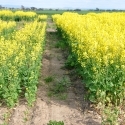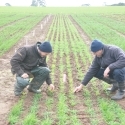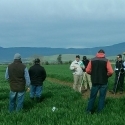10 Aug 2015
Topdressing for Irrigators - Technical Workshop
Finley, New South Wales
Nitrogen and Crop Production - the 4 R framework for Southeastern Australia grain production.
Nitrogen and phosphorus are usually the two most limiting nutrients for grain production in southeastern Australia, although attention should also be paid to sulfur, zinc, potassium and various trace elements to ensure balanced crop nutrition.
Other than when supplied by fertilizers, nitrogen is largely supplied by mineralization from organic N sources in the soil, and in a crop rotation. Mineralisation is most rapid with warm and moist soils, especially if cultivated. Legumes make significant contributions to this pool although the net N contribution of pulses such as peas and lupins can also be important. On average good pulse crop or pasture will fix enough N from the atmosphere for one or two non-legume crops depending on the demand. With a decline in the area of pasture legumes and the swing to more intensive cropping systems, the use of fertilizer N sources has become more common and management of this input is a large part of growing successful crops.
Nitrogen is removed from the soil in agricultural products and there can be other losses so that around half of the N applied can be recovered in grain.
Volatilization of N sources to the gas ammonia occurs on both acidic and neutral soils but is highest when N is surface applied and there is no rain to wash the N into the soil. Leaching of N to beyond the root zone occurs under high rainfall and on light textures soils. Some N can be immobilized back into organic sources including crop residues and soil organic matter. Under waterlogged conditions, nitrate can be converted to nitrous oxide (a potent greenhouse gas) and lost back to the atmosphere. The relative magnitude of these processes depends on the soil and climatic conditions, but N management should aim to balance input and output over time.
Our research indicates that there are no universal best bets for the 4R’s, with the best source being affected by the timing and placement of the fertilizer N source.
The Global “4R” Nutrient Stewardship Framework
Fertilizer Best Management Practices (BMPs) can be aptly described as the application of the right source (or product) at the right rate, right time and right place. Under the Global “4R” Nutrient Stewardship Framework, the four “rights” (4R) comprehensively convey how fertilizer applications can be managed to achieve economic, social and environmental goals. The framework ensures that FBMPs are developed with consideration of the appropriate focus on all three areas of sustainable development (see Figure 1).
Figure 1: The 4R’s approach to nutrient best management practice, to meet environmental, economic and social demands.
A copy of the 4R guide can be downloaded below.
Additional Resources
4R nitrogen maangement guide 2015Size: 1.2 MB
Norton Presentation Finley Print Version.pdfSize: 2.05 MB




